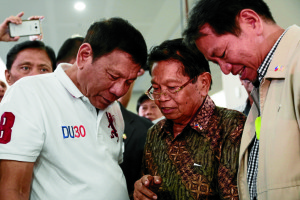
President Rodrigo Roa Duterte; Ghadzali Jaafar, MILF vice chairman for political affairs, and Lawyer Randolf Parcasio of the MNLF talk during the Mindanao Hariraya Eid’l Fitr in Davao City on July 8, 2016. PPD/Rene B. Lumawag
OZAMIZ CITY – The Philippine government and the Moro Islamic Liberation Front (MILF) have agreed to expand the membership of the Bangsamoro Transition Commission (BTC) to accommodate more voices in the process of crafting the charter of a new autonomy setup in Mindanao.
In a joint statement Sunday after a two-day meeting in Kuala Lumpur, the peace implementing panels of the parties said they have decided to increase the number of BTC members from the current 15 to 21 “to ensure inclusivity in the implementation of the GPH (Government of the Republic of the Philippines)-MILF Peace Agreement.”
Related to this, the panels recommended the issuance of a fresh executive order by the Office of the President constituting the BTC with expanded membership.
Under the Framework Agreement on the Bangsamoro (FAB), the BTC is tasked, among others, with writing the proposed charter of the Bangsamoro autonomous entity that will have greater powers and will replace the current Autonomous Region in Muslim Mindanao (ARMM).
The body was first created by President Aquino in 2012 through Executive Order No. 120 following the signing of the FAB in October 2012.
The BTC wrote the draft Bangsamoro Basic Law (BBL) that was submitted to the 16th Congress. The bill, however, failed to pass Congress.
Of the 21 BTC members, 11 will be nominated by the MILF and 10 by the government. All will be appointed by the President.
According to presidential adviser on the peace process Jesus Dureza, the reconstituted BTC will write another enabling law that will hopefully pass the 17th Congress even before the 1987 Constitution is subjected to amendments to accommodate a shift to a federal form of government.
Dureza earlier explained that by expanding its membership, the BTC would be able to “include leaders of the MNLF, officials of the ARMM, and other sectors in Mindanao for it to be inclusive.”
He stressed that in crafting the enabling law, “all sectors in the Bangsamoro must be adequately represented” and must “come together.”
Under the Bangsamoro peace roadmap of President Duterte, government seeks the convergence of the peace processes with the MILF and Moro National Liberation Front (MNLF), the main group that first waged the Moro rebellion in 1972 that later split up into factions.
The MNLF inked the Final Peace Agreement (FPA) with the administration of then President Fidel V. Ramos on Sept. 2, 1996.
Before flying to Kuala Lumpur Friday, Dureza held a meeting in Davao City with former Cotabato City mayor Muslimin Sema, head of the largest of the MNLF factions called the Council of 15.
Sema earlier joined hands with the MILF in finding ways to harmonize the respective peace pacts of the Philippine government with the MNLF and MILF.
The new peace roadmap provides that the writing of the proposed Bangsamoro charter will consider the Comprehensive Agreement on the Bangsamoro (CAB) that was signed in March 2014, the FPA of the MNLF, the key results of the 10-year Tripartite Review Process on FPA implementation, the Organic Act of the ARMM, and the Indigenous Peoples Rights Act (IPRA).
During his meeting with Dureza, Sema “expressed his commitment to join the BTC,” said a news release of the Office of the Presidential Adviser on the Peace Process (OPAPP).
In her opening address during kick off rites, government panel chair Irene Santiago drew attention to the composition of Duterte’s team for the Bangsamoro peace process.
She said that her panel members were drawn from among “the highest executives of OPAPP… to show that government is very serious in this phase of implementing the peace agreement not only with the MILF but also with the MNLF.”
Apart from Santiago, the government panel is composed of Undersecretaries Diosita Andot and Nabil Tan, and Assistant Secretaries Rolando Asuncion and Dickson Hermoso.
Andot is an old hand in the Bangsamoro peace process having served as head of the negotiating panel secretariat from 2001 to 2004 and director of a program for the development of once conflict-affected communities.
Tan has previously served the OPAPP while Asuncion has been in the agency for quite some time, now overseeing peace and development initiatives. Hermoso used to head the government’s contingent in the joint ceasefire body.
The MILF panel is composed of Mohagher Iqbal as chair, and Prof. Abhoud Syed Lingga, Abdullah Camlian, Said Sheik and Melanio Ulama as members.
Iqbal has been part of the negotiations since 1997, and has been chairing the MILF panel since 2003. Lingga and Camlian were members of the MILF negotiating panel that forged the CAB; Sheik served in the ceasefire mechanism; and Ulama, a Teduray leader, was a member of the board of consultants of the MILF for the negotiations.
Except for Lingga, all the four MILF panel members served in the BTC appointed by President Aquino.
The meeting of the panels over the weekend is the first formal one under the Duterte administration. Prior to this, there have been about three informal meetings between government and the MILF.
This includes one between Duterte and MILF chief Murad Ebrahim in Davao City, and between Dureza and Murad inside the rebel group administrative base, Camp Darapanan, in Sultan Kudarat, Maguindanao. SFM/rga

